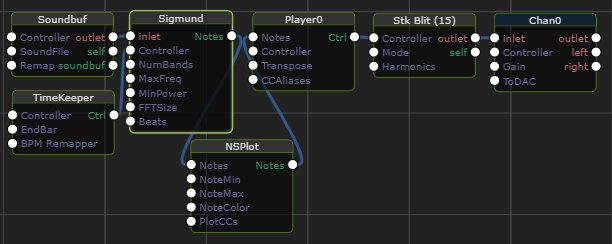/ Examples / NoteStream / Sigmund
NoteStreams .. Instruments
Filters .. Effects .. LiCK Effects
Plot .. Utility .. Pure ChucK
Wherein we present the modest details of the Sigmund node (chugin). Right-click to copy this example to your workspace
Sigmund
Sigmund is sinusoidal analysis and pitch tracking chugin. By Miller Puckette, Ron Mayer, …

inlet connect an input audio signal here.
Controller optionally connect a TimeKeeper or
SessionGrid in order to
sense performance completion.
NumBands controls the number of key-frequencies, or peaks to track.
Depending on the input signal, at any moment Sigmund locates and nominates
from 0 to NumBands "notes". It is advised to equip the player with
this same number of instrument instances downstream in order to avoid
dropping notes.
MaxFreq sets the highest frequency for Sigmund's tracker to consider.
Measured in Hz.
MinPower sets the minimum power within a band to establish it as trackable.
Measured in decibels above 0. Lower numbers produce a more sparse result.
The note sparsity for a given MinPower depends heavily upon the input signal.
FFTSize the size of the FFT. Must be a power of 2 and at least 128. You
need higher values to track lower frequencies. For example, at 1024
the lowest frequency that Sigmund can track is around 85 Hz.
Beats controls the sample rate for the tracker. It is measured
in TimeKeeper Beats.
The Example
In this example, Sigmund produces a pleasant notestream based on the
analysis of a speech by US President Obama. We've instantiated 15
instruments in this graph to allow for tweaking of NumBands. In
the out-of-box configuration, only 4 instruments are actually put
to use.

You can also see that we've routed the notestream to a Note Plot node. Below you can see the plot that is produced. Here time goes North/South and frequency goes West/East. We'll leave you to ponder the connection between our note plot and a Spectrogram.
